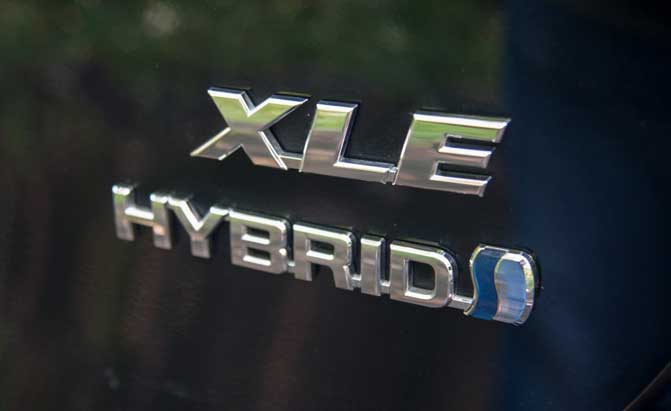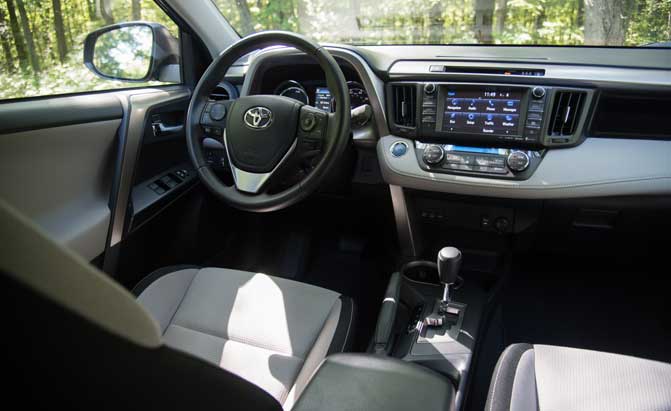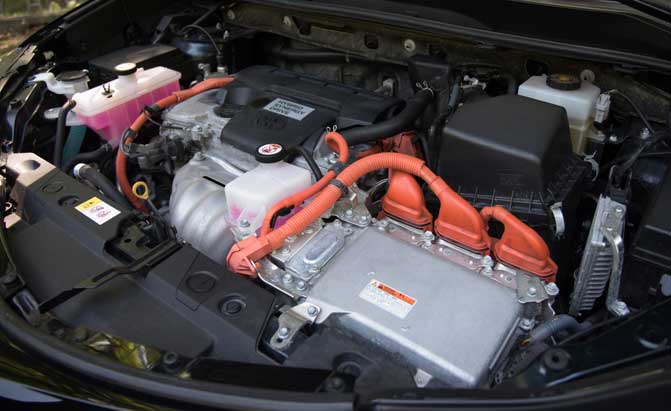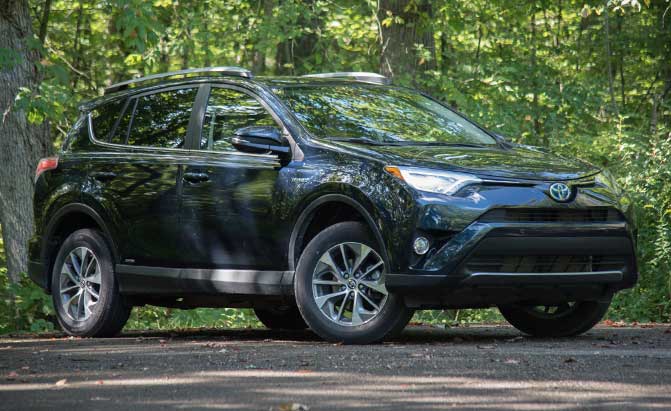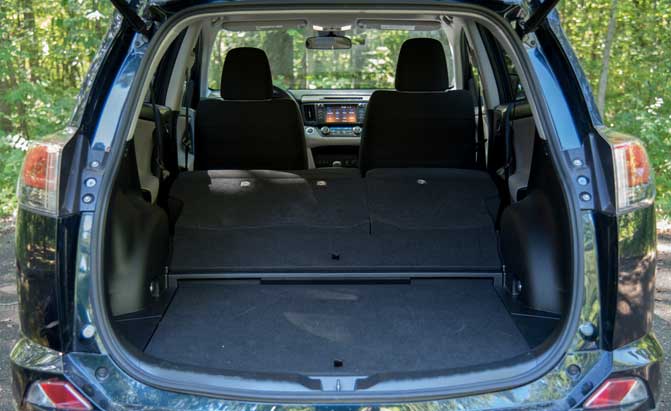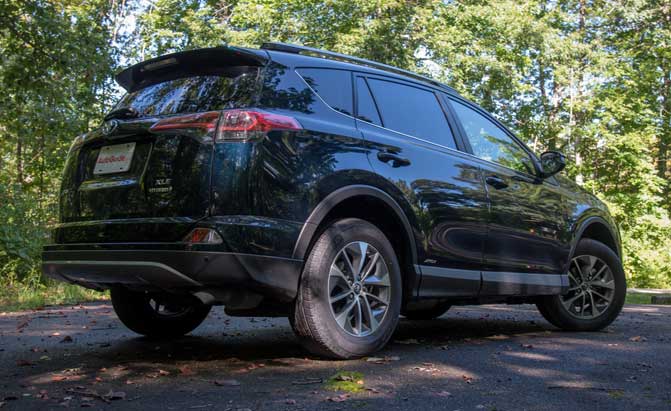Toyota has been selling hybrid vehicles for two decades now.
When the first-generation Prius launched in 1997, it was so far ahead of other cars on the market both in appearance and tech that it probably seemed like an alien spacecraft from the Procyon binary system had landed at dealerships.
But today, gasoline-electric vehicles are as common as craft beer, Wi-Fi hotspots or restaurant servers saying, “I’m going to be taking care of you.” The wide-eyed wonder provided by their circuit boards and battery packs has all but dissipated; now hybrids are just more efficient vehicles that cost a bit more than their standard counterparts.
Still, there must be something noteworthy about Toyota’s RAV4 Hybrid, aside from the girthy MPG figures printed on its window sticker, right? It competes in a ruthless segment chockablock with competent product. It must be a wholesome choice since it hasn’t yet been steamrolled by rivals.
The Basics
This small SUV is affordable, sips fuel and is more secure than Cheyenne Mountain, having garnered Top Safety Pick+ honors from the Insurance Institute for Highway Safety. It also comes standard with many of the latest driver-assistance aids, plus it has room for five adults and plenty of luggage.
RAV4 Hybrids are offered in three trim levels: XLE, SE, and Limited. Base price is $28,130 ($36,420 in Canada), roughly $5k ($7K in Canada) more than the most affordable version of Toyota’s standard gasoline-only RAV4. The test model I evaluated was exceedingly reasonable, driving off the assembly line in Obu, Japan, with a sticker price of $31,965, including $940 for delivery.
Compared to a base-level gas-burner, upgrades to this hybrid included things like 17-inch alloy wheels instead of steelies, push-button start, a moonroof and all-wheel drive. But the biggest differentiator is underneath; it’s the componentry you can’t see, not unless you have a box full of tools and a strong desire to squander an afternoon dissecting pricey driveline assemblies.
Cockpit Confidential
Taking a moment for inward reflection, on the RAV4 Hybrid’s interior that is, it’s unfortunately not going to win any awards. Sure, the cabin is mostly fine, but there’s hard plastic sprinkled throughout as well as some unusual design elements, like those strange vents on the upper portion of the dashboard. Further cheapening the overall experience, this vehicle’s rear door panels are wavy at the top, like the plastic warped after it was pulled from the injection molding machine.
Like other Toyotas, this one’s steering column is fully adjustable, well, sort of. In and out, up and down, it barely moves at all. What’s the point of offering this feature if it’s so limited? Brick walls have a greater range of motion than this tiller.
At least the RAV4 Hybrid has a lot of space. The rear seat is huge in all dimensions, easily accommodating members of the six-foot club, ditto for the cargo area, which is tall and broad. Seats up, there’s nearly 36 cubic feet of space (1,010 liters) available, drop them down and you get in excess of 70 cu-ft (2,000 L). That’s more in both measures than what’s provided by a Rogue Hybrid, Chevrolet Equinox or Ford Escape, though the Honda CR-V is a hair more capacious.
With the front passenger seat slid all the way forward, there’s 80-plus inches to play with, more than enough for most people to lie down and sleep, especially if they like the lumbar support since the floor is nowhere near flat. When folded “flat” those backrests form a ramp that would make skateboarding legend Tony Hawk proud.
Hybrid Synergy Drive
Blending internal combustion with electric motors, a small battery pack, and plenty of fancy software, this vehicle’s electrified drivetrain allows a spacious crossover to deliver compact car-rivaling fuel efficiency.
According to the EPA, RAV4 Hybrids are rated at 34 miles per gallon city (6.9 L/100 km) and 30 (7.8 L/100 km) on the highway. Combined, you can expect them to average 32 mpg (7.3 L/100 km). That compares quite favorably to
an all-wheel-drive Nissan Rogue Hybrid, which pips it at the post with a combined score of 33 (no Canadian ratings yet).
The RAV4 Hybrid’s powertrain is comprised of a 2.5-liter gasoline engine augmented by a pair of front-mounted motor-generators. A third one of these units is situated at the back, which provides four-corner traction by spinning the rear wheels. Total system output measures 194 horsepower, enough to propel this vehicle to 60 miles an hour in 8.1 seconds.
A nickel-metal hydride battery pack serves as an electron reservoir. With the RAV4 Hybrid in EV mode, it provides enough juice to travel a little more than half a mile at school-zone speed, so a dedicated electric vehicle this is not. It performs best in rush-hour traffic or snaking through urban congestion where it can use regenerative braking to recuperate kinetic energy that would normally be wasted.
The Drive
The RAV’s ride is both supple and refined, its chassis filtering out harsh impacts with cool confidence. It’s also very quiet. Despite all the cutting-edge stuff going on inside that hybrid drivetrain you basically feel and hear none of it.
This vehicle is smooth, too. The engine is barely felt as it goes about its business. Acceleration is more than adequate if far from blistering, which helps deliver exemplary efficiency. I routinely saw 34 mpg in the instrument cluster without even trying. Drivers more concerned about fuel efficiency or with a defter foot will undoubtedly coax even more out of this Toyota.
ALSO SEE: 2018 Honda Accord vs Toyota Camry Comparison
The rest of the RAV4 Hybrid’s driving experience is rather ho-hum. While there’s nothing major to gripe about, it’s nowhere as engaging as a Mazda CX-5 or likely even the Ford Escape. Efficiency and servility are the priorities here and in that order.
Keeping an extra eye on the road, Toyota Safety Sense P is now standard in every grade of RAV4. This suite of advanced driver-assistance goodies includes pre-collision warning with pedestrian detection, lane-departure alert, automatic high beams, dynamic radar cruise control and more, features that are slowly but surely becoming mainstream. Some enthusiasts might argue the addition of technology like this dilutes the driving experience but I’m actually all for its inclusion. Advanced driver aids can make long trips and morning commutes less stressful, plus they can help keep that inexperienced teen motorist, the one glued to Snapchat on their smartphone, from sideswiping you at freeway speed.
The Verdict: 2017 Toyota RAV4 Hybrid Review
The Toyota RAV4 Hybrid is a capable small utility vehicle with a roomy and comfortable interior, much-appreciated standard driver-assistance tech as well as outstanding fuel economy. An attractive price doesn’t hurt, either.
But it does fall a bit short in some important areas. That lumpy load floor, questionable interior, and disinterested dynamics take the shine off an otherwise fine vehicle.
Like many Toyota and Lexus models, this one hasn’t really wowed me. There’s just nothing about the RAV4 Hybrid that jumps out or makes you fall head-over-heels in love. It’s best at playing the role of ever-ready helper, loyal companion. In a weird way, it stands out from rivals by blending into the background, and there’s nothing wrong with that.
Discuss this story on our Toyota Forum







